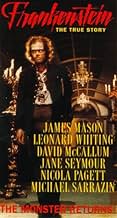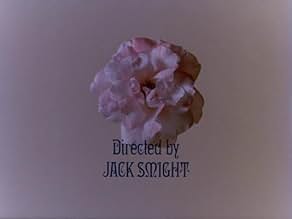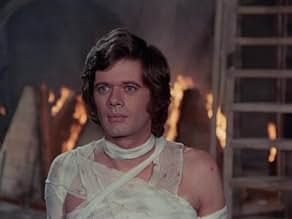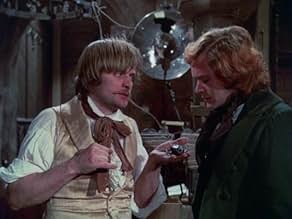अपनी भाषा में प्लॉट जोड़ेंWhen the brilliant but unorthodox scientist Dr. Victor Frankenstein rejects the artificial man that he has created, the Creature escapes and later swears revenge.When the brilliant but unorthodox scientist Dr. Victor Frankenstein rejects the artificial man that he has created, the Creature escapes and later swears revenge.When the brilliant but unorthodox scientist Dr. Victor Frankenstein rejects the artificial man that he has created, the Creature escapes and later swears revenge.
- निर्देशक
- लेखक
- स्टार
- पुरस्कार
- कुल 1 नामांकन
- Lady Fanshawe
- (as Clarissa Kaye)
फ़ीचर्ड समीक्षाएं
Simply stated, the film has a highly disconcerting and surprisingly overt homo-erotic edge. Instead of the inevitable "mad doctor" typical of films, Victor Frankestein is a remarkably handsome young man in the form of actor Leonard Whiting, a performer best known as Romeo in the famous 1968 ROMEO AND JULIET. He is seduced into the experiment by the equally handsome but distinctly odd Henry Clerval (David McCallum)--and not only do the two actors play the relationship in a disquietingly touchy-feely way, Clerval takes exception to Victor's fiancée Elizabeth (Nicola Pagett) and she returns the favor, demanding that Victor choose between them.
Lest any one miss the implications, the creature is played by none other than Michael Sarrazin, and while many men may be described as handsome, Sarrazin is among the few who can be justly described as beautiful. He arises from the laboratory table barely decent in a few strategically placed bandages, and when his facial covering is pulled aside by the eager Dr. Frankenstein we are treated to a lingering image of glossy black hair, pale complexion, remarkably liquid eyes, and lips that would make Vogue model weep with envy. Dr. Frankenstein takes him to his own apartment, where he educates this child-like innocent and very generously allows the creature to sleep in his own bed.
But, as in all FRANKENSTEIN movies, the experiment goes awry, and when it does the same disconcerting homo-erotic overtones take yet another turn. Due to some unknown error in the creation process, the creature begins to deteriorate in appearance--and instead of continuing to treat him kindly, Frankenstein keeps the creature locked up, becomes verbally abusive to him, and no longer allows the creature to sleep in his bed, relegating him to a cramped mattress on the floor. At the same time, Frankenstein is approached by the mysterious Dr. Polidori (the legendary James Mason), an oily scientist with a flair for hypnosis who claims to know what went wrong.
Polidori insists that they abandon the creature and create a new one: a woman, and when this new creation emerges from an entirely different process she too is remarkably beautiful; indeed, she is none other than Jane Seymour. But whereas the original creature was a gentle creature who only learned violence from Frankenstein's hateful rejection, this new entity is strangely icy, almost snake-like from the very beginning--and the male creature, now both vicious and wildly jealous, will exact a horrific toll upon all concerned.
It is worth pointing out that the script for this version of FRANKENSTEIN was co-authored by Christopher Isherwood (1904-1986), one of the few openly gay writers of his era. Sexuality in general and homosexuality in particular forms a theme in many of Isherwood's works, so it would seem reasonable to assume that he was responsible for the homo-erotic elements of the film. Jack Smight's direction does not offer anything nearly so interesting as the script, but it is workman-like, and while the production values tend to be a shade too baroque for their own good one never lacks for something to look at on the screen.
The cast is also quite good. At the time, the film was looked upon as a "television event," and it drew a host of noted actors, including John Gielgud and Agnes Moorehead. No one would accuse Leonard Whiting of being a great screen talent, but he acquits himself very well; so too does David McCallum, Nicola Pagett, and the always memorable James Mason. But the real knock-out performances here are by Sarrazin and Seymour, who truly blow the lid off our ideas of what a FRANKENSTEIN movie should be--and when they square off the result is unsettling in a truly unexpected way. In terms of the DVD itself, the film quality is considerably better than the rare late-night showings I've occasionally seen on television, but I would not describe it as pristine, and I found I frequently had to bump up the volume on the soundtrack.
If you are looking for something with which to scare yourself silly, you might want to give this version FRANKENSTEIN a miss; although it has a few visceral moments, the jolts involved are largely psycho-sexual. But if you are open to the sexually subversive, which is particularly unexpected in a made-for-television film from 1973, you couldn't make a better choice. Recommended.
GFT, Amazon Reviewer
The all-star British/American cast and the production design gave it the old-time feel of early films from both the Universal and Hammer Studios genres, yet the sharp writing by Don Bachardy and Christopher Isherwood lent an almost Merchant-Ivory sense of credibility that most films of this kind can't even hope to pull off.
Even more surprising that the director, Jack Smight, was better known for his work on television series and disaster films than on something as well-crafted as this.
And the performances...In a cast of well-seasoned veterans, it's almost impossible to cite stand-out favorites, but if I had to, Michael Sarrazin's Creature is one of the most outstanding to be introduced out of the many versions, and definitely the most multi-layered and sympathetic, (which would not be equalled until twenty-years on, by Clancy Brown in the less-superior THE BRIDE.) Worth equal praise is the rivalry between David McCallum, Leonard Whiting and the always-dependable James Mason as the brilliantly twisted Dr. Polidori (affectionately known now and forever as "Polly-dolly.")
And what review would be complete without mentioning Jane Seymour as Prima. I won't spoil the shock and surprise involved with her character and Sarrazin's, but needless to say that was ONE scene that made quite an impression on my young mind, (and for those who remember, you know EXACTLY which part I'm referring to!) It was quite an introduction to a lovely young ingenue, who would become even more memorable to American audiences less than a year later with her big screen debut, as Bond girl Solitaire in Roger Moore's initial 007 outing, LIVE AND LET DIE.
It may not exist in its original form, as previous reviewers have pointed out, but one can only hope for a newly restored and uncut DVD version of this classic TV gem. In an age of bloated, overproduced blockbusters like TITANIC and PEARL HARBOR, the 240-minute version of this outstanding drama would be more than worth your time. Now here's hoping we'll get the opportunity to see it again, as it was intended.
Leonard Whiting plays Dr. Victor Frankenstein, who, spurred on by the untimely death of his younger brother, tries to find a way to bring the dead back to life, aided in his quest by the like-minded Dr. Clerval (David McCallum), who has developed a special serum and revolutionary solar power source for just this purpose, and who unwittingly provides the brain for their creation by suddenly dropping dead. The experiment seemingly a success, Victor sets about introducing his surprisingly handsome creature' (Michael Sarrazin) to high-class London society, unaware that a reversal in the reanimation process is gradually causing physical abnormalities. Horrified at his increasingly ugly countenance, the creature becomes suicidal, but, already being dead, finds killing himself harder than he thinks.
Meanwhile, Clerval's previous scientific associate, Dr. John Polidori (the amazing James Mason), arrives on the scene hoping to join forces with Frankenstein to perfect the process. When the first creature accidentally kills the beautiful daughter of a blind man, he supplies Polidori and Frankenstein with the final components for a second creation: a beautiful woman that they name Prima (played by drop-dead gorgeous Jane Seymour). Her introduction to the social elite causes problems between Victor and his pregnant wife Elizabeth (Nicola Pagett), and with the creature, who, now horribly disfigured, is jealous of the attention that Prima is receiving.
Things proceed to go downhill for Victor Frankenstein - as they always seem to do for those who dabble in such ungodly matters - leading to a tragic finale on a ship bound for America, but redirected to the North Pole by the creature.
The incredible cast - which also includes the likes of Agnes Moorehead, Ralph Richardson, John Gielgud, Peter Sallis, and Tom Baker in cameo roles - rarely put a foot wrong, with Sarrazin making for an especially brilliant sympathetic monster, while Seymour's Prima is quite the opposite, a beautiful but soul-less creation, every bit as wicked as her mentor Polidori. Director Jack Smight proves a far more capable director than his primarily TV-based resumé suggests, largely handling the material with restraint, thus making the occasional grisly moment all the more effective: a reanimated severed arm that just won't stay put is quite unnerving, but it is the creature settling the score with Prima in front of a horrified crowd of posh onlookers that is the shocking showstopper. Visually, the film is impressive throughout, with a special mention for the colourful second experiment, Prima brought to life in a vat of swirling rainbow coloured liquids and bubbles - worthy of the great Terence Fisher himself.
8/10. The three hour plus runtime and gradual pace might occasionally have you looking at the clock to see how much time is left, but don't let that put you off, for there is so much here to enjoy.
क्या आपको पता है
- ट्रिवियाThe character "Dr. Polidori" is not in Mary Shelley's novel, although he includes elements of Victor Frankenstein's mentors, Doctors Waldman and Krempe. He is primarily based on Dr. Septimius Pretorius from The Bride of Frankenstein (1935), but the name had to be changed because the Pretorius character is not in the public domain. He is named for Shelley's friend John William Polidori, who wrote a novella called "The Vampyre," which he began in the same weekend that she got the idea to write "Frankenstein". Polidori served as doctor for Lord Byron, who mockingly called him "Pollydolly", just like Clerval does in the film.
- गूफ़When Polidori introduces Victor to the creature in his carriage, the interior point of view shot shows a Chinese servant closing the carriage door. A split second later, in a reverse angle shot from the exterior, the servant has vanished.
- भाव
Dr. Henry Clerval: You're afraid. I was afraid at first. It's the way we've been brought up. We've been brought up to fear! To fear the punishment of the gods. But Prometheus defied them.
Dr. Victor Frankenstein: And they punished him!
Dr. Henry Clerval: He scorned their punishment. So has every other hero that's stolen secrets from nature to give to mankind.
- इसके अलावा अन्य वर्जनThe widely seen version features a prologue with James Mason visiting the supposed grave of Mary Shelley. However, test screenings showed a longer prologue, depicting Mary Shelley and her friends coming up with the Frankenstein story at a Swiss villa, similar to the opening of The Bride of Frankenstein (1935). This was cut and replaced by the simpler version after the test audiences were bored by it.
- कनेक्शनFeatured in Der phantastische Film: Frankenstein, wie er wirklich war 1 (1980)
टॉप पसंद
विवरण
- रिलीज़ की तारीख़
- कंट्री ऑफ़ ओरिजिन
- आधिकारिक साइट
- भाषाएं
- इस रूप में भी जाना जाता है
- Frankenstein, wie er wirklich war
- फ़िल्माने की जगहें
- उत्पादन कंपनी
- IMDbPro पर और कंपनी क्रेडिट देखें
- चलने की अवधि3 घंटे 5 मिनट
- ध्वनि मिश्रण
इस पेज में योगदान दें





































